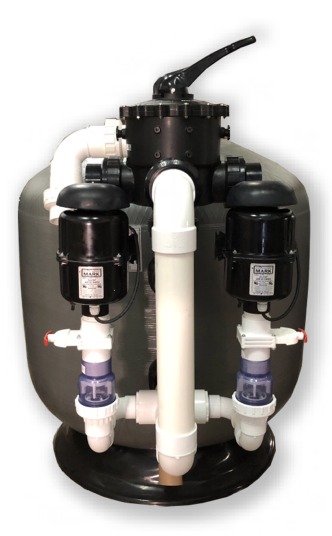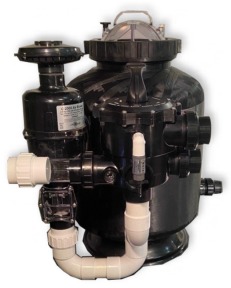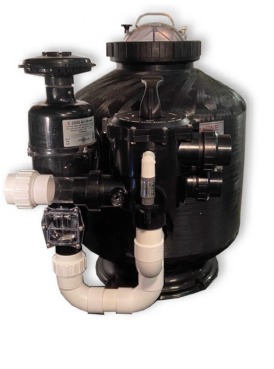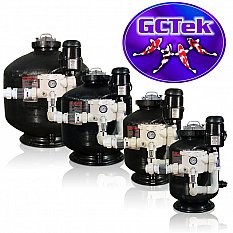GC Tek Bead Filter Sizing
- How do we know how much bio conversion can be accomplished with a bead filter?
- Is there a standard to go by, or do we just take a look at the competition and then add a few points in our favor?
This is how!
University tests have shown that a cubic foot of beads that have 400 - 450 cu. ft. of surface area will handle 50 lbs. of fish being fed 1% body weight per day @ 38% protein.
This is the formula that we use, even though our beads have 500 to 550 sq. ft. of surface area per cu. ft. and in theory should do more, we refuse to stretch or make claims beyond what has truly been tested.
| Model |
Size (cu. ft.) |
Max Pond Size |
Flow Rate (gpm) |
Fish Load (lbs.) |
Dimensions |
| AquaBead 2.50 |
2.5 |
5,000 gallons (U.S.) |
70 gpm |
125 lbs. |
21" x 34.5" |
| AquaBead 4.25 |
4.25 |
10,000 gallons (U.S.) |
90 gpm |
225 lbs. |
24.5" x 35.5" |
| AquaBead 6.0 |
6.0 |
17,000 gallons (U.S.) |
120 gpm |
300 lbs. |
30.4" x 40" |
|
AquaBead 10.0
|
10.0 |
25,000 gallons (U.S.) |
180 gpm |
500 lbs. |
36.4" x 45" |
Choosing the right size bead filter for your pond or aquarium is crucial to ensuring effective filtration and maintaining a healthy environment for your fish. At GC Tek, we have provided a comprehensive guide to how we size our bead filters. By considering the key factors influencing bead filter sizing, you can make an informed decision and select the right filter for your system. You can enjoy a clean and clear pond or aquarium for years with the right bead filter.
1. How does GC Tek size its bead filters?
GC Tek sizes bead filters based on the surface area of the beads and the fish load. Tests show that a cubic foot of beads with 400-450 sq. ft. of surface area can handle 50 lbs. of fish. Despite their beads having 500-550 sq. ft. of surface area, GC Tek sticks to tested numbers for accurate sizing.
2. How do I know how much bio-conversion a bead filter can handle?
Bio-conversion capacity is determined by the bead surface area, which impacts how many fish can be supported. GC Tek’s formula assumes 50 lbs. of fish per cubic foot of beads, based on university tests at a feeding rate of 1% body weight per day on a 38% protein diet.
3. Is there a standard for sizing bead filters?
While there is no universal standard, GC Tek uses proven research data for sizing, rather than relying on competitor claims. This ensures that their bead filters deliver accurate and reliable performance.
4. How do I choose the right size filter for my pond?
Consider your pond size, fish load, and desired flow rate. Each AquaBead model is designed for specific pond sizes, and selecting the right one ensures efficient filtration and a healthy environment for your fish.
5. Why does GC Tek not overstate their bead filter's capabilities?
GC Tek values accuracy and reliability, which is why they adhere to proven testing rather than making overstated claims, ensuring that their filters perform exactly as expected.









